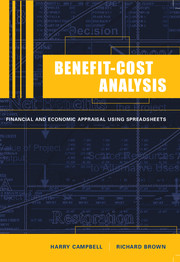Book contents
- Frontmatter
- Contents
- List of figures
- List of tables
- Preface
- Acknowledgements
- 1 Benefit-Cost Analysis: Introduction and Overview
- 2 Investment Appraisal: Principles
- 3 Investment Appraisal: Decision-Rules
- 4 Private Benefit-Cost Analysis: Financial Analysis
- 5 Efficiency Benefit-Cost Analysis
- 6 Calculating the Net Benefits to the Referent Group
- 7 Consumer and Producer Surplus in Benefit-Cost Analysis
- 8 Valuing Traded and Non-traded Commodities in Benefit-Cost Analysis
- 9 Incorporating Risk in Benefit-Cost Analysis
- 10 The Social Discount Rate, Cost of Public Funds, and the Value of Information
- 11 Weighting Net Benefits to Account for Income Distribution
- 12 Valuation of Non-marketed Goods
- 13 Economic Impact Analysis
- 14 Writing the Benefit-Cost Analysis Report
- Appendix 1 Case Study Assignment
- Appendix 2 Discount and Annuity Tables
- Index
4 - Private Benefit-Cost Analysis: Financial Analysis
Published online by Cambridge University Press: 05 September 2012
- Frontmatter
- Contents
- List of figures
- List of tables
- Preface
- Acknowledgements
- 1 Benefit-Cost Analysis: Introduction and Overview
- 2 Investment Appraisal: Principles
- 3 Investment Appraisal: Decision-Rules
- 4 Private Benefit-Cost Analysis: Financial Analysis
- 5 Efficiency Benefit-Cost Analysis
- 6 Calculating the Net Benefits to the Referent Group
- 7 Consumer and Producer Surplus in Benefit-Cost Analysis
- 8 Valuing Traded and Non-traded Commodities in Benefit-Cost Analysis
- 9 Incorporating Risk in Benefit-Cost Analysis
- 10 The Social Discount Rate, Cost of Public Funds, and the Value of Information
- 11 Weighting Net Benefits to Account for Income Distribution
- 12 Valuation of Non-marketed Goods
- 13 Economic Impact Analysis
- 14 Writing the Benefit-Cost Analysis Report
- Appendix 1 Case Study Assignment
- Appendix 2 Discount and Annuity Tables
- Index
Summary
Introduction
As noted in Chapter 1, social benefit-cost analysis takes a wide, “social” perspective in the context of investment appraisal – it measures and compares the costs and benefits experienced by all members of “society”. In contrast, when a project is being evaluated by a private or public enterprise from a purely commercial or “private” perspective, account is taken only of the benefits and costs of the project that accrue to the enterprise itself and that affect its profitability. The project may have wider implications – environmental and employment effects, for example – but if these do not affect the enterprise's commercial profitability, they are omitted from the private analysis.
It is to be expected that the private enterprise would already have undertaken a private investment analysis of the project and will be basing its investment decision on the results of that analysis. However these results may not be available to the public sector decision-maker, and the social benefit-cost analysis, using discounted cash flow techniques very similar to those used in private benefit-cost analysis, and incorporating a private analysis, may be important in helping the public decision-maker decide what incentives are required in the form of tax concessions, for example, to induce the firm to undertake the project. For this reason the appraisal of a proposed project from a purely private viewpoint is often an integral part of a social benefit-cost analysis undertaken by the project analyst. This Chapter focuses on the methodology of private benefit-cost analysis, using discounted cash flow (DCF) analysis.
- Type
- Chapter
- Information
- Benefit-Cost AnalysisFinancial and Economic Appraisal using Spreadsheets, pp. 62 - 91Publisher: Cambridge University PressPrint publication year: 2003



